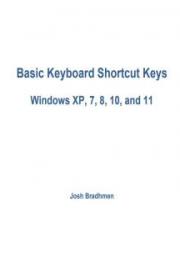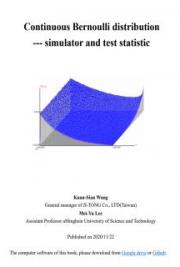Windows Command Prompt
Windows command prompt is also known as "cmd.exe" or simply "cmd". It is a command line interpreter on windows CE and Windows NT operating systems, Also it is the analogue of COMMAND.COM in DOS and windows 9x systems or of the UNIX shells used on UNIX like systems. The Command Prompt program allows you to work in an environment that looks more like a traditional operating system as opposed to the icon based Windows environment. In Command Prompt, you will use your keyboard. You won't use your mouse at all.
Command Prompt works at a lower level than Windows. This means that you will have more control over the machine. The disadvantage is that it is less user-friendly.
Many of the Windows 8 Command Prompt commands are very similar to MS-DOS commands. But, the Command Prompt in Windows 8 is not MS-DOS so the commands are not correctly referred to as MS- DOS's commands.
To reach command prompt you can simply switch to the "RUN" by pressing WINDOW+R and type "cmd" and hit enter. The command prompt will be pop out. A screenshot of the command prompt is attached above for your familiarity to the GUI of the command prompt.


Let's start messing with the commands in the windows
command prompt.
The dos commands are listed downstairs: -
APPEND
The append command can be used to open files in another directory as if they were located in the current directory.

The append command is accessible in MS-DOS as lavishly as in around 32-bit versions of Windows but shamefully the append simulate is not at hand in 54-bit versions of Windows8.
ARP
The arp command is worn to express or lodgings entries in the ARP cache. The arp command is reachable in on wide sides versions of windows.

ASSOC
The assoc command is used to display or change the file type associated with a particular file extension. The assoc command is available in Windows 8, Windows 7, Windows Vista, and Windows XP.
 AT
AT
The at command is used to schedule commands and other programs to run at a specific date and time. The at role of is at hand in Windows 7, Windows Vista, and Windows XP.
ATMADM
The atmadm command is second- hand to publish inform accessory to asynchronous transfer mode (ATM) connections on the system.
The atmadm command is available in Windows XP.
Support for ATM was removed beginning in Windows Vista, making the atmadm command unnecessary.
ATTRIB
The attrib command is used to change the attributes of a single file or a directory.

AUDITPOL
The auditpol command is used to display or change audit policies.

BCDBOOT
The bcdboot command is used to copy boot files to the system partition and to create a new system BCD store.

BCDEDIT
The bcdedit command is employed to look at or build changes besides Configuration knowledge.
BDEHDCFG
The bdehdcfg command is employed to arrange a tough drive for BitLocker Drive encoding.

BITSADMIN
The bitsadmin command is employed to make, manage, and monitor transfer and transfer jobs.
While the bitsadmin command is accessible in Windows eight, you ought to apprehend that it's being phased out. The BITS PowerShell cmdlets ought to be used instead.

BOOTCFG
The bootcfg command is employed to make, modify, or read the contents of the boot.ini file, a hidden file that's accustomed determine in what folder, on that partition, and on that drive Windows is found.

The bootcfg command was replaced by the bcdedit command starting in Windows visual image. Bootcfg remains offered in Windows eight however it serves no real price since boot.ini isn't used.
BOOTSECT
The bootsect command is used to configure the master boot code to one compatible with Windows 8 (BOOTMGR).The bootsect command is only available from the Command in System Recovery Options prompt.
BREAK
The break command sets or clears extended CTRL+C checking on DOS systems.
The break command is available in Windows 8 to provide compatibility with MS-DOS files but it has no effect in Windows 8 itself.
CACLS
The cacls command is used to display or change access control lists of files. Even though the cacls command is available in Windows 8, it's being phased out. Microsoft recommends that you use the icacls command instead.
CALL
The call command is employed to run a script or batch program from among another script or batch program.

The call command has no result outside of a script or batch file. In alternative words, running the call command at the prompt can do nothing.
CD
The Cd command is the shorthand version of the chdir command.
CERTREQ
The certreq command is used to perform various certification authority (CA) certificate functions.


CERTUTIL
The certutil command is used to dump and display certification authority (CA) configuration information in addition to other CA functions.
CHANGE
The change command changes various terminal server settings like install modes, COM port mappings, and logons.

CHCP
The chcp command displays or configures the active code page number.
CHDIR
The chdir command is used to display the drive letter and folder that you are currently in. Chdir can also be used to change the drive and/or directory that you want to work in.
CHECKNETISOLATION
checknetisolation c Chglogon
The chglogon command allows, disables, or drains terminal server session logins. Executing the chglogon command is that the same as executing modification logon.

CHGPORT
The chgport command can be used to display or change COM port mappings for DOS compatibility. Executing the chgport command is the same as executing change port.
CHGUSR
The chgusr command is used to change the install mode for the terminal server.
Executing the chgusr command is the same as executing change user.
CHKDSK
The chkdsk command, often referred to as check disk, is used to identify and correct certain hard drive errors.
CHKNTFS
The chkntfs command is used to configure or display the checking of the disk drive during the Windows boot process.
CHOICE
The choice command is used within a script or batch program to provide a list of choices and return of the value of that choice to the program.
CIPHER
The cipher command shows or changes the encryption status of files and folders on NTFS partitions.
CMD
The cmd command starts a new instance of the command interpreter to test apps that require network capabilities
CMDKEY
The cmdkey command is used to show, create, and remove stored user names and passwords.
CMSTP
The cmstp command installs or uninstalls a Connection Manager service profile.
COLOR
The color command is used to change the colors of the text and background within the Command Prompt window.
COMMAND
The "command" command starts a new instance of the command.com command interpreter.
The 'command' command is not available in 54-bit versions of Windows 8.
COMP
The comp command is used to compare the contents of two files or sets of files.
COMPACT
The compact command is used to show or change the compression state of files and directories on NTFS partitions.
CONVERT
The convert command is used to convert FAT or FAT32 formatted volumes to the NTFS format.
COpy
The copy command does simply that - it copies one or more files from one location to another.
CSCRIpT
The cscript command is employed to execute scripts via Microsoft Script Host.
The cscript command is most typically wont to manage printing from the command line with scripts like prncnfg.vbs, prndrvr.vbs, prnmngr.vbs, and others.
DATE
The date command is used to show or change the current date
DEBUG
The debug command starts Debug, a command line application used to test and edit programs.
The debug command is not available in 54-bit versions of Windows 8.
DEFRAG
The defrag command is employed to defragment a drive you specify. The defrag command is that the instruction version of Microsoft's Disk Defragmenter.
DEL
The del command is used to delete one or more files. The del command is the same as the erase command.
DIR
The dir command is employed to show an inventory of files and folders contained within the folder that you simply ar presently operating in. The dir command additionally displays alternative vital info just like the onerous drive's serial variety, the full variety of files listed, their combined size, the full quantity of free area left on the drive, and more.
DISKCOMP
The diskcomp command is used to compare the contents of two floppy disks.
DISKCOPY
The diskcopy command is used to copy the entire contents of one floppy disk to another.
DISKPART
The diskpart command is used to create, manage, and delete hard drive partitions.
DISKPERF
The diskperf command is employed to manage disk performance counters remotely.
The diskperf command was helpful for disk performance counter administration in Windows nongovernmental organization and 2000 however square measure for good enabled in Windows eight.
DISKRAID
The diskraid command starts the DiskRAID tool which is used to manage and configure RAID arrays.
DISM
The dism command starts the readying Image service and Management tool (DISM). The DISM tool is employed to manage f Dispdiag .
The dispdiag command is employed to output a log of knowledge regarding the show system.
DJOIN
The djoin command is used to create a new computer account in a domain.
DOSKEY
The doskey command is used to edit command lines, create macros, and recall previously entered commands.
DOSX
The dosx command is employed to begin DOS Protected Mode Interface (DPMI), a special mode designed to provide Microsoft disk operating system applications access to over the commonly allowed 640 KB.
The dosx command isn\\\'t accessible in 64-bit versions of Windows eight.
The dosx command (and DPMI) is just accessible in Windows eight to support older Microsoft disk operating system programs.
DRIVERQUERY
The driverquery command is used to show a list of all installed drivers.
ECHO
The echo command is employed to point out messages, most typically from inside script or batch files. The echo command can even be accustomed flip the reverberant feature on or off.
EDIT
The edit command starts the MS-DOS Editor tool which is used to create and modify text files.
The edit is not available in 54-bit versions of Windows 8.
EDLIN
The edlin command starts the Edlin tool that is employed to make and modify text files from the instruction.
The edlin command isn\\\'t on the market in 54-bit versions of Windows eight.
ENDLOCAL
The endlocal command is used to end the localization of environment changes inside a batch or script file.
ERASE
The erase command is used to delete one or more files. The erase command is the same as the del command.
ESENTUTL
The esentutl command is used to manage Extensible Storage Engine databases.
EVENTCREATE
The eventcreate command is used to create a custom event in an event log.
EXE2BIN
The exe2bin command is employed to convert a file of the EXE file kind (executable file) to a computer file.
The exe2bin command isn't offered in 54-bit versions of Windows8.
EXIT
The exit command is used to end the Command Prompt session that you're currently working in.
EXPAND
The expand command is used to extract a single file or a group of files from a compressed file.
EXTRAC32
The extrac32 command is employed to extract the files and folders contained in Microsoft cupboard (CAB) files.
The extrac32 command is really a CAB extraction program to be used by web human however may be wont to extract any Microsoft cupboard file. Use the expand command rather than the extrac32 command if doable.
FASTOPeN
The fastopen command is employed to feature a program's disk drive location to a special list hold on in memory, probably up the program's launch time by removing the necessity for DOS to find the appliance on the drive.
The fastopen command isn't out there in 54-bit versions of Windows8. Fastopen solely exists in 32-bit versions of Windows eight to support older DOS files
Fe
The fc command is used to compare two individual or sets of files and then show the differences between them.
FIND
The find command is used to search for a specified text string in one or more files.
FINDSTR
The findstr command is used to find text string patterns in one or more files.
FINGER
The finger command is used to return information about one or more users on a remote computer that's running the Finger service.
FLTMC
The fltmc command is used to load, unload, list, and otherwise manage Filter drivers.
Fondue
The fondue command, short for options on Demand User expertise Tool, is employed to put in any of the many ex gratia Windows eight options from the command line.
Optional Windows 8 features can also be installed from the
Programs and Features applet in Control Panel.
FOR
The for command is used to run a specified command for each file in a set of files. The for command is most often used within a batch or script file.
FORFILES
The forfiles command selects one or more files to execute a specified command on. The forfiles command is most often used within a batch or script file.
FORMAT
The format command is used to format a drive in the file system that you specify.
Drive formatting is also available from Disk Management within Windows 8.
FSUTIL
The fsutil command is employed to perform varied FAT and NTFS classification system tasks like managing reparse points and thin files, dismounting a volume, and increasing a volume.
FTP
The ftp command can used to transfer files to and from another computer. The remote computer must be operating as an FTP server.
FTYPE
The ftype command is used to define a default program to open a specified file type.
GETMAC
The getmac command is used to display the media access control (MAC) address of all the network controllers on a system.
GOTO
The goto command is used in a batch or script file to direct the command process to a labeled line in the script.
GPRESULT
The gpresult command is used to display Group Policy settings.
GPUPDATE
The gpupdate command is used to update Group Policy settings.
GRAFTABL
The graftabl command is employed to alter the power of Windows to show Associate in nursing extended listing in graphics mode.
The graftabl command isn't obtainable in 54-bit versions of Windows eight.
GRAPHICS
The graphics command is used to load a program that can print graphics.
The graphics command is not available in 54-bit versions of Windows 8.
HELP
The help command provides more detailed information on other Command Prompt commands.
HOSTNAME
The hostname command displays the name of this host.
The hwrcomp command is employed to compile custom dictionaries for handwriting recognition.
HWRREG
The hwrreg command is used to install a previously compiled custom dictionary for handwriting recognition.
ICACLS
The icacls command is used to display or change access control lists of files. The icacls command is an updated version of the cacls command
If the if command is used to perform conditional functions in a batch file.
IPCONFIG
The ipconfig command is employed to show careful IP data for every network adapter utilizing TCP/IP. The ipconfig command may also be accustomed unleash and renew IP addresses on systems designed to receive them via a DHCP server.
IRFTP
The irftp command is used to transmit files over an infrared link. Iscsicli
The iscsicli command starts the Microsoft iSCSI Initiator, used to manage iSCSI.
KB16
The kb15 command is used to support MS-DOS files that need to configure a keyboard for a specific language.
The kb15 command is not available in 54-bit versions of Windows 8.
KLIST
The klist command is used to list Kerberos service tickets. The klist command can also be used to purge Kerberos tickets.
KSETUP
The ksetup command is used to configure connections to a Kerberos server.
KTMUTIL
The ktmutil command starts the Kernel Transaction Manager utility.
LABEL
The label command is used to manage the volume label of a disk.
LICENSINGDIAG
The licensingdiag command is a tool used to generate a text- based log and other data files that contain product activation and other Windows licensing information.
LOADFIX
The loadfix command is used to load the specified program in the first 64K of memory and then runs the program.
The loadfix command is not available in 64-bit versions of Windows 8.
LODCTR
The lodctr command is used to update registry values related to performance counters.
LOGMAN
The logman command is used to create and manage Event Trace Session and Performance logs. The logman command also supports many functions of Performance Monitor. Logoff
The logoff command is used to terminate a session.
LPQ
The lpq command displays the status of a print queue on a computer running Line Printer Daemon (LPD).
LPR
The lpr command is used to send a file to a computer running
Line Printer Daemon (LPD).
The lpr command is not available by default in Windows 8 but can be enabled by turning on the LPD Print Service and LPR Port Monitor features from Programs and Features in Control Panel.
MAKECAB
The makecab command is used to losslessly compress one or more files. The makecab command is sometimes called Cabinet Maker.
MANAGE-BDE
The manage-bde command is used to configure BitLocker
Drive Encryption from the command line.
MD
The md command is the shorthand version of the mkdir command.
MEM
The mem command shows information about used and free memory areas and programs that are currently loaded into memory in the MS-DOS subsystem.
The mem command is not available in 54-bit versions of Windows 8.
MKDIR
The mkdir command is used to create a new folder.
MKLINK
The mklink command is used to create a symbolic link.
MODE
The mode command is used to configure system devices, most often COM and LPT ports.
MORE
The more command is used to display the information contained in a text file. The more command can also be used to paginate the results of any other Command Prompt command.
MOUNTVOL
The mountvol command is used to display, create, or remove volume mount points.
MOVE
The move command is used to move one or files from one folder to another. The move command is also used to rename directories.
MRINFO
The mrinfo command is used to provide information about a router's interfaces and neighbors
MSG
The msg command is used to send a message to a user.
MSIEXEC
The msiexec command is used to start Windows Installer, a tool used to install and configure software.
MUIUNATTEND
The muiunattend command starts the Multilanguage User
Interface unattended setup process.
NBTSTAT
The nbtstat command is used to show TCP/IP information and other statistical information about a remote computer.
NET
The net command is used to display, configure, and correct a wide variety of network settings.
NETl
The net1 command is used to display, configure, and correct a wide variety of network settings.
NETCFG
The netcfg command is used to install the Windows Preinstallation Environment (WinPE), a lightweight version of Windows used to deploy workstations. Netsh
The netsh command is used to start Network Shell, a command-line utility used to manage the network configuration of the local, or a remote, computer.
NETSTAT
The netstat command is most commonly used to display all open network connections and listening ports.
NLSFUNC
The nlsfunc command is used to load information specific to a particular country or region.
The nlsfunc command is not available in 54-bit versions of Windows 8 and is only available in 32-bit versions to support older MS-DOS files.
NLTEST
The nltest command is used to test secure channels between Windows computers in a domain and between domain controllers that are trusting other domains.
The nltest command was first available in Windows 8.
NSLOOKUP
The nslookup is most commonly used to display the hostname of an entered IP address. The nslookup command queries your configured DNS server to discover the IP address.
OCSETUP
The ocsetup command starts the Windows Optional Component Setup tool, used to install additional Windows features.
OPENFILES
The openfiles command is used to display and disconnect open files and folders on a system.
PATH
The path command is used to display or set a specific path available to executable files.
PATHPING
The pathping command functions much like the tracert command but will also report information about network latency and loss at each hop.
PAUSE
The pause command is used within a batch or script file to pause the processing of the file. When the pause command is used, a Press any key to continue... message displays in the command window.
PING
The ping command sends an Internet Control Message Protocol (ICMP) Echo Request message to a specified remote computer to verify IP-level connectivity.
PKGMGR
The pkgmgr command is used to start the Windows Package Manager from the Command Prompt. Package Manager installs, uninstalls, configures, and updates features and packages for Windows.
PNPUNATTEND
The pnpunattend command is used to automate the installation of hardware device drivers
PNPUTIL
The pnputil command is used to start the Microsoft PnP Utility, a tool used to install a Plug and Play device from the command line.
POPD
The popd command is used to change the current directory to the one most recently stored by the pushd command. The popd command is most often utilized from within a batch or script file.
POWERCFG
The powercfg command is used to manage the Windows power management settings from the command line.
PRINT
The print command is used to print a specified text file to a specified printing device.
PROMPT
The prompt command is used to customize the appearance of the prompt text in Command Prompt.
PUSHD
The pushd command is used to store a directory for use, most commonly from within a batch or script program.
PWLAUNCHER
The pwlauncher command is used to enable, disable, or show the status of your Windows To Go startup options.
QAPPSRV
The qappsrv command is used to display all Remote Desktop
Session Host servers available on the network.
QPROCESS
The qprocess command is used to display information about running processes.








 AT
AT













